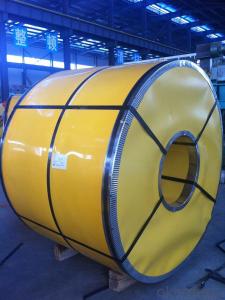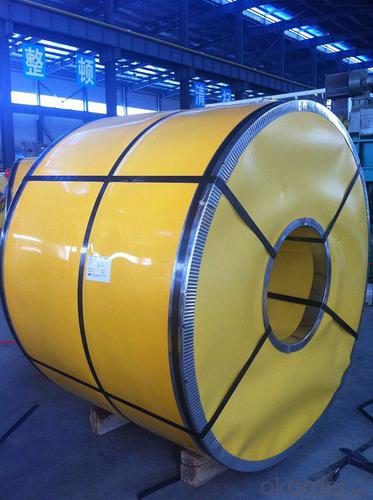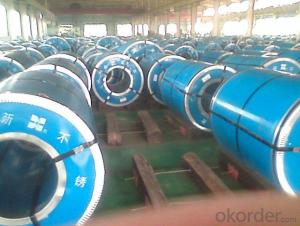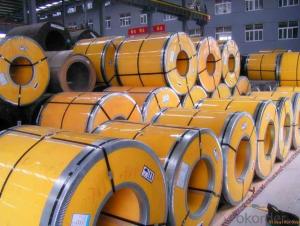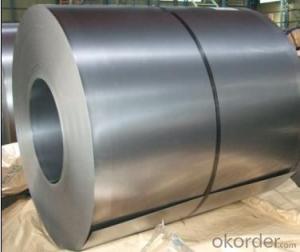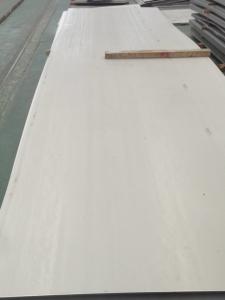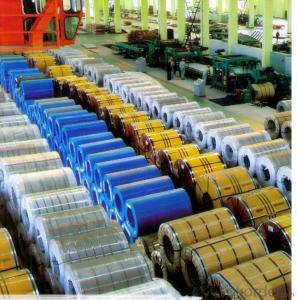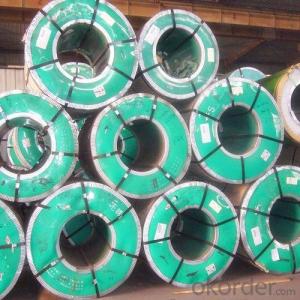Hot Rolled Stainless Steel Coil 304
- Loading Port:
- Qingdao
- Payment Terms:
- TT OR LC
- Min Order Qty:
- -
- Supply Capability:
- 5000 m.t./month
OKorder Service Pledge
OKorder Financial Service
You Might Also Like
Hot Rolled Stainless Steel Coil 304
Stainless steel is a production which not easy rust,acid resistance and corrosion resistance,so it is widely
used in light industry,heavy industry,daily necessities and the decoration industry.my company long-term
supply stainless steel porducts including:stainless steel sheet,stainless steel coil and stainless steel tube.
Specifications
1.surface:NO.1
2.standard:JIS, AISI, GB
3.width: 0.55m, 0.65m, 1.0m, 1.22m, 1.5m, 2.0m or requirement
ASTM 304
(%):C=0.07, Mn=2.00, P=0.045, S=0.030, Si=0.075, Cr=17.5-19.5, Ni=8.0-10.5, N=0.10
Physical Properties
Tensile strength σb (MPa) ≥ 520
the conditions yield strength σ0.2 (MPa) ≥ 205,
elongation δ5 (%) ≥ 40
Reduction of ψ (%) ≥ 50,
hardness: ≤ 187
HB; ≤ 90
HRB; ≤ 200H
Type | Hot Rolled Stainless Steel Coil 304 |
Thickness | 3.0mm-4.0mm |
Width | 550mm, 650mm, 1000mm, 1219mm, 1240mm, 1500mm |
Length | according to weight |
Brand name | CNBM |
Standard | ASTM, AISI, DIN, GB, JIS etc |
Material | 304 |
Application | Foodstuff, Gas, metallurgy, biology, electron, chemical, petroleum, boiler, nuclear energy, Medical equipment, fertilizer etc |
Package | Standard export sea-worthy packing |
Delivery time | Within 15 days since getting the deposit or LC origin |
Surface | NO.1 |
Productivity | 5000 tons/month |
- Q: Can stainless steel strips be used in oil and gas industries?
- Indeed, the oil and gas industries can utilize stainless steel strips. Renowned for its exceptional resistance to corrosion, impressive strength, and long-lasting nature, stainless steel proves to be an optimal material for various applications within the oil and gas sector. By employing stainless steel strips, one can manufacture pipes, tubes, fittings, valves, heat exchangers, and other components that encounter challenging operational conditions such as corrosive surroundings, elevated temperatures, and intense pressures. Moreover, stainless steel boasts commendable weldability and formability, thereby enabling effortless fabrication and installation in oil and gas facilities. In summary, stainless steel strips offer the essential dependability and performance that the oil and gas industry necessitates.
- Q: What are the recommended guidelines for machining 111 stainless steel strips?
- When machining 111 stainless steel strips, it is recommended to follow certain guidelines to ensure optimal results. 1. Selection of cutting tools: Use cutting tools specifically designed for machining stainless steel. Carbide or high-speed steel tools are suitable options. Ensure the tools are sharp and in good condition. 2. Cutting speed: Maintain a moderate cutting speed to prevent excessive heat buildup. Generally, a cutting speed between 80 and 100 surface feet per minute (SFPM) is recommended for 111 stainless steel strips. 3. Feed rate: Use a feed rate that allows for efficient material removal without causing excessive tool wear. A feed rate of 0.005 to 0.015 inches per revolution (IPR) is typically suitable for 111 stainless steel strips. 4. Coolant and lubrication: Apply a suitable coolant or lubricant during the machining process. This helps reduce friction, heat, and tool wear. Water-soluble or oil-based coolant/lubricant can be used as per the machining conditions. 5. Tool geometry: Choose the appropriate tool geometry, such as a positive rake angle, to minimize cutting forces and improve chip evacuation. This helps prevent work hardening and tool breakage. 6. Workholding: Ensure secure and rigid workholding to minimize vibrations and improve surface finish. Use clamps or vice grips that provide sufficient grip without distorting the strips. 7. Chip control: Employ effective chip control measures, such as using chip breakers or chip evacuation systems, to prevent chip buildup and damage to the tool or workpiece. 8. Quality control: Regularly monitor the machining process to ensure dimensional accuracy, surface finish, and adherence to tolerances. Use appropriate measuring tools, such as calipers or micrometers, for quality control checks. 9. Safety precautions: Always follow safety guidelines and wear appropriate personal protective equipment (PPE) when machining stainless steel. This includes safety glasses, gloves, and hearing protection. It is important to note that these guidelines serve as general recommendations. The specific machining conditions, such as the width and thickness of the strips, the desired surface finish, and the machinery used, may require adjustments to these guidelines. Therefore, it is advisable to consult the manufacturer's recommendations and perform test cuts to optimize the machining process for 111 stainless steel strips.
- Q: Can stainless steel strips be used in chemical pumps?
- Indeed, chemical pumps can employ stainless steel strips for their operation. Stainless steel boasts remarkable resistance against corrosion and can endure exposure to a diverse array of chemicals. It finds widespread application in the fabrication of chemical pumps and other apparatuses that encounter corrosive substances. By utilizing stainless steel strips, the pump's robustness and longevity are secured, rendering it apt for handling a multitude of chemical variants.
- Q: How do stainless steel strips resist stress corrosion cracking in chloride environments?
- Stainless steel strips resist stress corrosion cracking in chloride environments due to the presence of chromium in the alloy. Chromium forms a protective oxide layer on the surface of the steel, which acts as a barrier against corrosive chloride ions. This oxide layer prevents the penetration of chloride ions into the metal, reducing the risk of stress corrosion cracking.
- Q: What are the different types of edges for stainless steel strips?
- The different types of edges for stainless steel strips include mill edge, slit edge, deburred edge, and rounded edge.
- Q: Can stainless steel strips be used in marine vessel construction?
- Yes, stainless steel strips can be used in marine vessel construction. Stainless steel is highly resistant to corrosion, making it an excellent choice for marine applications. It is able to withstand exposure to saltwater, which is highly corrosive, without rusting or deteriorating. Stainless steel strips can be used in various areas of a marine vessel, including the hull, deck, fittings, and equipment. Its durability, strength, and resistance to corrosion make it a reliable material for constructing marine vessels that can withstand the harsh conditions of the ocean.
- Q: What is the maximum width available for stainless steel strips?
- The maximum width of stainless steel strips can differ based on the manufacturer and supplier. Generally, these strips are typically found in widths that range from 0.5 inches to 24 inches. Moreover, certain manufacturers may provide wider strips, reaching up to 48 inches or even more, depending on their production facilities' capabilities and the specific requirements. To ascertain the precise maximum width capabilities for stainless steel strips, it is crucial to consult with individual suppliers.
- Q: Can 111 stainless steel strips be used in the aerospace industry?
- In the aerospace industry, it is possible to utilize 111 stainless steel strips. Thanks to its remarkable strength, resistance to corrosion, and ability to withstand high temperatures, stainless steel is well-suited for various purposes within this industry. The 111 grade stainless steel, a variation of austenitic stainless steel, is particularly favorable due to its excellent formability and weldability. Consequently, it is frequently employed in aerospace applications that necessitate both exceptional strength and resistance to corrosion. Prominent examples include aircraft components, engine parts, and structural components. However, it is crucial to acknowledge that the aerospace industry's specific requirements and regulations may differ. Therefore, it is necessary to consult professionals within the field and strictly adhere to applicable specifications and standards. This is vital to ensuring the suitability and safety of implementing 111 stainless steel strips in aerospace applications.
- Q: Are stainless steel strips suitable for roofing applications?
- Yes, stainless steel strips are suitable for roofing applications. Stainless steel is highly resistant to corrosion, making it an excellent choice for roofing materials, especially in areas with harsh weather conditions or high levels of pollution. Stainless steel strips offer durability, longevity, and low maintenance requirements, making them a cost-effective option in the long run. Additionally, stainless steel has a high strength-to-weight ratio, which means it can withstand heavy loads without compromising the structural integrity of the roof. Furthermore, stainless steel strips are fire-resistant and can effectively reflect sunlight, reducing heat absorption and energy costs. Overall, stainless steel strips are a reliable and practical choice for roofing applications.
- Q: Can stainless steel strips be used for automotive suspension components?
- Automotive suspension components can indeed utilize stainless steel strips. Renowned for its remarkable strength, resistance to corrosion, and durability, stainless steel proves to be a fitting material for diverse automotive uses, including suspension components. Springs, brackets, and other crucial parts necessary for the suspension system can be efficiently manufactured using stainless steel strips. These components must endure substantial loads, vibrations, and exposure to varying environmental conditions, and stainless steel's properties establish it as a dependable choice for such rigorous applications. Furthermore, the corrosion resistance of stainless steel guarantees an extended lifespan for suspension components, even in the face of harsh conditions. Thus, stainless steel strips present a practical alternative for automotive suspension components.
Send your message to us
Hot Rolled Stainless Steel Coil 304
- Loading Port:
- Qingdao
- Payment Terms:
- TT OR LC
- Min Order Qty:
- -
- Supply Capability:
- 5000 m.t./month
OKorder Service Pledge
OKorder Financial Service
Similar products
Hot products
Hot Searches
Related keywords
